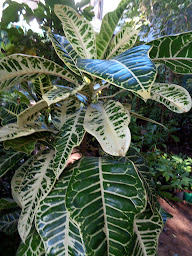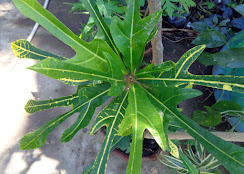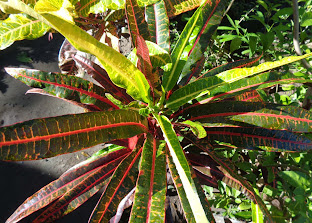Ten Paradigms of Moral Life
"In uplifting humanity to its finest hour against the current COVID-19 pandemic."
A paradigm is a distinct set of concepts or thought patterns, including theories, research methods, postulates, and standards for what constitutes legitimate contributions to a field. Synonyms: model, pattern, example, exemplar, template, standard, prototype, archetype.
Dr Abe V Rotor
Living with Nature - School on Blog
Here are ten (10) models of moral life characteristic of each of the periods of history, including that of the present, in man's relentless search of the true meaning of life that earns him his salvation for an eternal life.
1. Classical Period (Pre-Vatican)
“What must I do?”
The models in this period which dominated the Christian world for centuries are Noah’s Flood, and Sodom and Gomorrah. The salvation of man lies in himself alone let his sinful society perish, if that is the will of God.
Many who have seen or heard Lakay Lakay, a figure of an old man and woman off the coast of Ilocos Norte and Cagayan, know it is the local version of this model. Even today sea travelers throw money into the water as their boat passes through the rough waters surrounding it with the hidden fear of biblical Armageddon.
Thus, a sinful people meet a dreadful fate, save he who is good. This is the rule that governed the faithful during this period. Who is considered good?
First of all, he who believes in a God who punishes the wicked and rewards the good – typical in the preaching of the early missionaries such as Reverend Hale in James Michener’s novel, Hawaii.
First of all, he who believes in a God who punishes the wicked and rewards the good – typical in the preaching of the early missionaries such as Reverend Hale in James Michener’s novel, Hawaii.
 The world virtually stood still as the masters feasted on their colonies. With the missionaries they took advantage of the promise that the soul will be freed from the suffering body and reach Heaven, the ultimate reward for living in asceticism.
The world virtually stood still as the masters feasted on their colonies. With the missionaries they took advantage of the promise that the soul will be freed from the suffering body and reach Heaven, the ultimate reward for living in asceticism. Christ's passion and death keeps the Christian world alive. Angels' Hill, Tagaytay
Obedience was the rule and this rule remained unquestioned, save local revolts and tragic protests like those of Diego Silang and GOMBURZA (Gomez, Burgos and Zamora). The masters stayed too long in their colonies and enraged the people. Soon colonization gave way to the birth of nations. But first, let me present the transitory paradigm during the historical period.
2. Historical Paradigm
“What do I want to become?”
To better appreciate this concept let us first examine this parallelism in the context of history and evolution. Here we also take note of the reasons underlying this paradigm shift in the next period - the historical period.
Enlightenment dawned in this period. Education began to catalyze the acquisition of knowledge among the subjects. “Education is the key to independence,” said Rizal. The so-called Third World countries followed this formula with or without armed revolution. Or it inspired revolution itself. “Noli” and “Fili” inflamed the Katipunan.
Spirituality took several steps down from its pedestal of dogmas to have a “dialogue with the world.” The wheels of time moved faster, the unquestioning subjects soon entered the age of realism. Man, to be good, must realize the unity of body and soul, and the root of spirituality cannot be in the soul alone.
Women, though still looked down by society, began to see opportunities outside the confines of housekeeping. While facing the horizon of self actualization, the road that led the liberated societies was still the long and winding historical road that dictated many of their thoughts and acts. For example, truth is still historical truth. As the old folks would say, “I have eaten more rice than you had.”
But things have changed, particularly to the younger generations. The Sodom and Gomorrah model began to melt, and the concept of sin is no longer one that is indulgence or omission, but “breaking relationships” with God and fellowmen. This means, “We go to Heaven together.” Or vice versa. Which is the essence of the New Testament.

3. Liberation Theology
“What do we want for an alternative society?”
Freed from their master the subjects faced self-rule. The end led however, to autocracy. Dictatorships prevailed where people were weak. The few where wealth and power were concentrated took the helm of government. A new master was born.
The paradox is even greater if we take the case of the woman who is now doubly jeopardized of her status of being a woman and at the same time poor. For poverty plagued the newly independent states now depleted of resources. Neophyte managers ran new governments poorly. These scenarios naturally led to a paradigm still reminiscent of the cities of the French Revolution, which sought social justice, this time addressed to the new master in cohort with the old one. Here Liberation means first and foremost, meeting the people’s basic needs, removal of inequities of wealth distribution, respect of the rights of the common man. It was also a call for the end of the vestiges of colonialism in the guise of capitalism. Thus, the birth of the masses. Conflict then moved away from the “David and Goliath” model. There must be a solution to an “Abel and Cain” conflict.
To poor people, God is a God of the poor. Being poor is also historical but people cannot accept that. It is structural. Unjustly structural, like the pork barrel and other hidden compensation for members of congress. What is sin then?
From the viewpoint of this paradigm, sin is likewise structural. Graft and corruption is structural sin. If the dialectics is that poverty is the result of unjust structure, this model calls also for a dialectical method: bring out the conflict.
Liberation from sin is not being passive, but active participation in bringing about a new society, as Christ died to redeem the sins of mankind.
4. Feminist Theology
“Where art thou, woman?”
The breed of Tandang Sora and Joan of Arc’s local version, Gabriela Silang, comes to the picture in this period. Recently at one time five world leaders were women sitting side by side with men plotting the course of world affairs.
Had it not been for the paradigm of this period, the world would hear more of the whimpers and moans of a suffering woman, cast away from a man’s world. Her DNA is no different from the male’s, and that is a biological fact. Physical, mental, sexual and emotional attributes, scientists say, are potentially equal. Thus, the birth of Women’s Lib. And man found a partner at work and at home. Breadwinning is shared, so with housekeeping.
The dignity of a person is in accepting responsibility. When one accepts responsibility one also exercises freedom to choose and to decide. Liberation theology plus feminist theology points out one important aspect of this paradigm which has a social dimension. Here the woman rises and history will never be a history solely that of men. While sin in man is pride, in women it is passivity. “I think therefore, I am,” to women becomes more compassionate and caring. Breaking from passivity brings into the woman self-worth and self-assertion, and above all, wholeness of being.
5. Ecological paradigm
Reverence for Life is the key to salvation
The prolificacy of the human species sans war and pestilence, plus growing affluence of its societies led to a population explosion, doubling in less than 50 years. We are now 7.5 billion.
In this paradigm, master and subject have joined hands to exploit the earth’s finite resources. Our best economists are the worst housekeepers of Nature. While they aim for the good life, they have unwittingly reduced the very foundation of that good life – the productivity and beauty of Mother Earth.
Reverence for Life Painting in acrylic AVRotor
Ecological paradigm endorses an eco-centric approach where all forms of life and non-life are important to human life. Spirituality points out to a unitive force: the sacredness of everything. God’s divinity flows in everything. There is integration in the universe. And we are part of that integration, exceedingly small as we are, notwithstanding.
The kind of person we truly are is reflected by our relationship with Mother Earth, how we comply under her treaties. Clearly, biocide is the greatest sin man commits in this period. Long live, Ceres! And Albert Schweitzer and King Solomon must be smiling up there. So with St. Francis of Assissi, patron saint of ecology. “Reverence for life,” is the key to this paradigm.
6. In Search of Sacredness in Postmodern Times
 “Why can’t many people find sacredness anymore?” asked Time in a special issue. Moses asked the same question, puzzled on why his people had turned their worship to a golden calf. Christ released His anger, the first and only instance, when the synagogue was turned into a marketplace.
“Why can’t many people find sacredness anymore?” asked Time in a special issue. Moses asked the same question, puzzled on why his people had turned their worship to a golden calf. Christ released His anger, the first and only instance, when the synagogue was turned into a marketplace.I remember Alvin Toffler’s books “Future Shock” and “Eco-Spasm”. We are unprepared visitors of a changed planet who broke away too soon with the past. We are willing victims of an accelerated thrust of time and change. We are a people of the future too soon, carried away by the concept of transience and adhocracy, and not one of permanence. We created a throw-away society that we discard many things including values in favor of novelty.
San Lorenzo Ruiz is the layman's saint and the most recently canonized. Will the people follow his path? Angels' Hills, Tagaytay
We find little sacredness when we talk in the future tense, of foreign ideologies not founded by enduring philosophies, but of futurism, its promises of choice and kaleidoscopic images. How can we find sacredness in subterranean cities, in modular fun houses, in sprawling mega malls, in mail-a-bride and rent-a-person, in hurry-up welcome, in Batman, in temporary marriages? Welcome to the rental revolution, to simulated environments, the portable playground.
Gone is the homing instinct. Broken is the old family. If we are a product of periodicity, then we are but a drifting lead swept onto the ocean of change. No, we are not.
Here we remember the classical period, the anchor against the fallacy of human dreams and ambitions. What caused the downfall of Alexander and Napoleon? Here we remember the historical period. History is the greatest lesson of mankind. He who knows his history does not run and get a stabbing thorn. He who walks sees reality and the beauty of the countryside.
We remember liberation theology – it is the catalyst of social justice; the feminist paradigm – it gives wholeness to man-woman relationship; the Filipino paradigm, the quaintness of Filipino life, shy from the world, but full of life’s simplicity as well as flavors, while ecological paradigm is making us move closer to nature.
Will a worldwide web bind all of us, Christians and Jews, Muslims and Buddhists, together?
7. Finding God on the Web
The Computer Revolution is touching our faith more openly and deeply now than during the age of Bible Study and Sunday Worship.
Futuristic tree of life, product of Genetic Engineering. Painting in acrylic AVRotor 2001
Time poses this question with a sense of optimism that opens the door to religious understanding rather than religious isolation and conflict. These electronic exchanges will ultimately help people from many religions understand the common ideas that bind them together.
“One of the causes of religious disagreement has been the sense of strangeness, of pure unfamiliarity,” Professor Alvin Plantinga, Notre Dame University
8. Rise of the "nones." These are former members of religious organizations who have moved away to practice their own faith individually or as a community. They are disillusioned by their religious institutions, many of them overly strict and dogmatic and provide very little room for freedom of worship followers are seeking to express their faith in the light of today's postmodern living.
They have grown suspicious of the true intentions of their religious institutions which have become financial giants and their leaders wallowing in amassed wealth, while the faithful are kept in silence and obedience. The nones have not abandoned their faith whatsoever. The fact that they have been liberated allows them to exercise in their own way to be of better service to their respective communities, attending to the poor and destitute, in a kind of missionary zeal, even with the use of their own resources.
The world is about to plunge into a giant pool called globalization where the dividing lines of distinction begin to dissolve: sex, geography, public and private life, status, race, religion, trade, education, culture, many others. Will these end up into a “classless and society.” What paradigm do all these offer for one in order to lead a true moral life?
9. Same sex marriage defy natural laws and institutions of marriage and family - Never Never in the history of mankind has marriage of the same sex allowed in any civilization, and if there were cases, these were made clandestinely so as to escape social criticism and banishment. Would legal sanction remove moral guilt? Would a general referendum speak of, and for others? Consequences are raised in questions of
Relentless exploitation and destruction of the environment which the Pope blamed on apathy, the reckless pursuit of profits, excessive faith in technology, and political short sightedness.
The encyclical is a nudge for action particularly in countries that are largely catholic, although the pope asked that the encyclical "to address every person living on this planet."
The encyclical is interpreted as an attack on capitalism and as unwanted political meddling at a moment when climate change is high on the global agenda.
They have grown suspicious of the true intentions of their religious institutions which have become financial giants and their leaders wallowing in amassed wealth, while the faithful are kept in silence and obedience. The nones have not abandoned their faith whatsoever. The fact that they have been liberated allows them to exercise in their own way to be of better service to their respective communities, attending to the poor and destitute, in a kind of missionary zeal, even with the use of their own resources.
The world is about to plunge into a giant pool called globalization where the dividing lines of distinction begin to dissolve: sex, geography, public and private life, status, race, religion, trade, education, culture, many others. Will these end up into a “classless and society.” What paradigm do all these offer for one in order to lead a true moral life?
9. Same sex marriage defy natural laws and institutions of marriage and family - Never Never in the history of mankind has marriage of the same sex allowed in any civilization, and if there were cases, these were made clandestinely so as to escape social criticism and banishment. Would legal sanction remove moral guilt? Would a general referendum speak of, and for others? Consequences are raised in questions of
- procreation
- property
- investing into the future
- family structure
- community
- economy
- salvation
- others
Relentless exploitation and destruction of the environment which the Pope blamed on apathy, the reckless pursuit of profits, excessive faith in technology, and political short sightedness.
The encyclical is a nudge for action particularly in countries that are largely catholic, although the pope asked that the encyclical "to address every person living on this planet."
The encyclical is interpreted as an attack on capitalism and as unwanted political meddling at a moment when climate change is high on the global agenda.
- Areas of concern
- Redefining progress
- Integrated ecology
- Business and environment
- Failures of leaders
- Reluctance of rich nations
- Creation as God's love
- People and nature
- Global warming evidences
- Morality, common good
As I walk on the road of change, I see a faint light from the window of an old house. It gives me comfort, more than all the stars I see above. ~
Lesson on former Paaralang Bayan sa Himpapawid (People's School-on-Air) Dr Abe V Rotor and Ms Melly C Tenorio 738 DZRB AM Band, 8 to 9 evening class Monday to Friday
































































